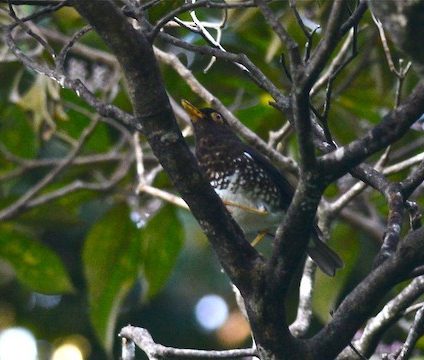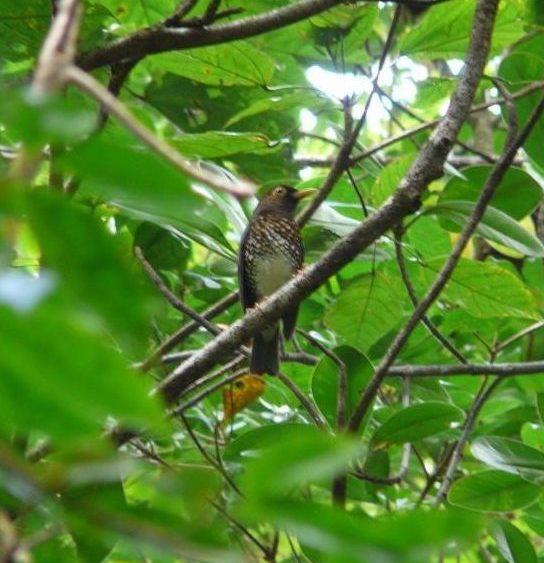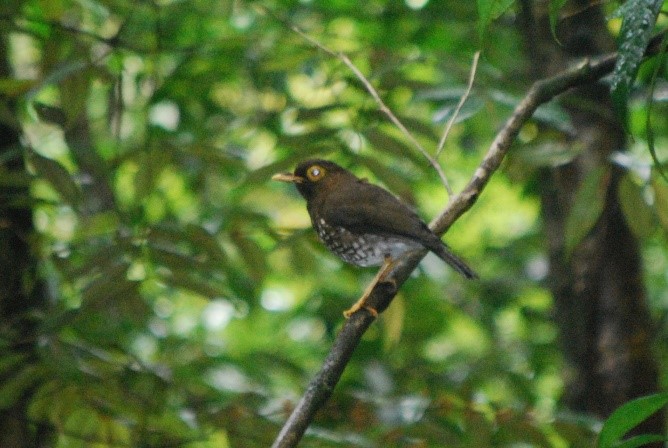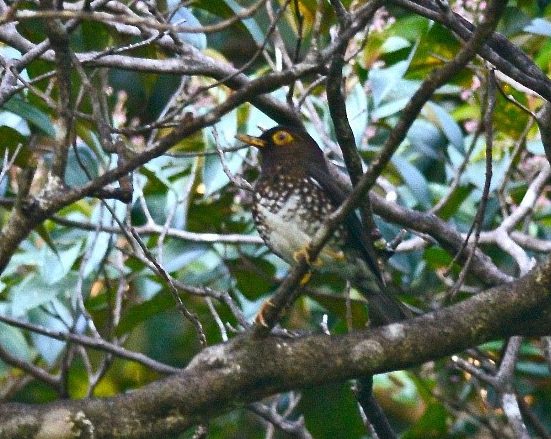Birdfinding.info ⇒ The Dominican endemic form of Forest Thrush is locally common in mature forests of the western slopes and interior of the island. A shy bird of the forest interior, it can be heard, and less often seen, along the Syndicate Trail, at the Emerald Pool, and in Morne Tres Pitons National Park.
“Dominica Forest Thrush”
Turdus lherminieri dominicensis
Endemic to Dominica, where it inhabits primary humid forest.
Identification
Dark brown overall with a blackish crown and face, a largely white lower breast and belly, and a brown-and-white scaly pattern on the transitional area of the upper breast, sides and flanks. It has a pronounced yellow eyering, bill, and legs.

“Dominica Forest Thrush,” T. l. dominicensis. (Morne Diablotin National Park, Dominica; March 19, 2014.) © Alan Van Norman

“Dominica Forest Thrush,” T. l. dominicensis. (Morne Tres Pitons National Park, Dominica; March 11, 2009.) © Ian Hempstead

“Dominica Forest Thrush,” T. l. dominicensis. (Morne Tres Pitons National Park, Dominica; May 14, 2009.) © Hans Holbrook

“Dominica Forest Thrush,” T. l. dominicensis. (Dominica; February 5, 2008.) © Harald Bott

“Dominica Forest Thrush,” T. l. dominicensis. (Emerald Pool, Dominica; December 12, 2000.) © JFC
Notes
Monotypic form of Forest Thrush that is potentially a separate species.
IUCN Red List Status: Vulnerable.
Frontiers of Taxonomy: The Forest Thrush Complex.
The internal taxonomy of the Forest Thrush complex is unresolved and in need of revision. Recent research suggests that it may consist of multiple species, with the populations on Montserrat and Guadeloupe comprising one species with three subspecies, and the populations on Dominican and St. Lucia both likely recognizable as separate species—although the St. Lucia form evidently died out in the late 1900s.
The “Dominica Forest Thrush”, T. l. dominicensis, differs visibly and vocally from those of Montserrat and Guadeloupe. Visibly, the Dominica form is darker brown overall and has a white belly, and a finer scaling pattern on the breast and flanks. Vocally, its song is simpler, choppier, and less musical than “Northern’s”, and includes a sharp upslurred note frequently interspersed (and likely differs in other ways, but few recordings of Forest Thrush songs are available for a more thorough review).
The “St. Lucia Forest Thrush”, T. l. sanctaeluciae, has not been reliably reported in recent decades and is likely extinct. Although Forest Thrushes are secretive and difficult to see, they are not difficult to hear, so the failure of intensive searches to locate any singing individuals strongly suggests that sanctaeluciae no longer exists. Documentation of its appearance and song is not readily available, so its distinctness is difficult to evaluate, but geography and the isolation of dominicensis suggest that sanctaeluciae must have been at least as divergent genetically as dominicensis—probably more so given that it was separated by a much greater distance, including the island Martinique, where no subspecies of Forest Thrush has been recorded.
The populations of Montserrat and Guadeloupe—currently designated as T. l. dorotheae and lherminieri—generally resemble one another, but show significant divergence in measurements and genetic markers. However, the research of Arnoux et al. (2014) indicates that the populations of eastern and western Guadeloupe are more divergent from one another than from the Monstserrat population, which indicates that there should be two subspecies recognized on Guadeloupe. With recognition of the Dominica and St. Lucia forms as distinct, and named accordingly, the natural designation for the remaining group would be “Northern Forest Thrush,” T. l. lherminieri.
References
Arnoux, E., C. Eraud, N. Navarro, C. Tougard, A. Thomas, F. Cavallo, N. Vetter, B. Faivre, and S. Garnier. 2014. Morphology and genetics reveal an intriguing pattern of differentiation at a very small geographic scale in a bird species, the forest thrush Turdus lherminieri. Heredity 113:514-525.
BirdLife International 2018. Turdus lherminieri. The IUCN Red List of Threatened Species 2018: e.T22708544A132073400. http://dx.doi.org/10.2305/IUCN.UK.2018-2.RLTS.T22708544A132073400.en. (Accessed August 31, 2019.)
Collar, N. 2019. Forest Thrush (Turdus lherminieri). In Handbook of the Birds of the World Alive (J. del Hoyo, A. Elliott, J. Sargatal, D.A. Christie, and E. de Juana, eds.). Lynx Edicions, Barcelona. https://www.hbw.com/node/58323. (Accessed August 31, 2019.)
eBird. 2019. eBird: An online database of bird distribution and abundance. Cornell Lab of Ornithology, Ithaca, N.Y. http://www.ebird.org. (Accessed August 31, 2019.)
Raffaele, H., J. Wiley, O. Garrido, A. Keith, and J. Raffaele. 1998. A Guide to the Birds of the West Indies. Princeton University Press, Princeton, N.J.
